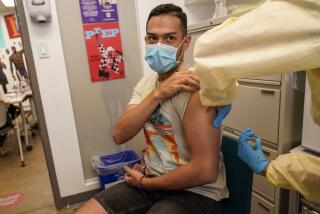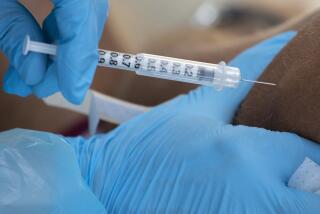Infection Tied to Smallpox Vaccine
- Share via
A patient has been hospitalized in Los Angeles County with an eye infection acquired through close contact with someone inoculated in the military’s smallpox vaccination program, health officials said.
The adult patient, who has not been identified, is the first person in California to be hospitalized as a result of the national drive to vaccinate emergency health workers and military personnel.
More than 100,000 members of the military have been vaccinated, and three cases of adverse reactions have been reported.
Citing privacy and confidentiality measures, public health officials declined to release the Los Angeles County patient’s gender or age, to identify the hospital or to say how the patient was being treated. However, officials said the patient’s condition was improving.
How the patient became infected by the vaccinia virus -- derived from the stomachs of calves -- is still unclear, said Dr. Jonathan Fielding, the county’s director of public health.
“We really don’t know how it happened -- it could have happened in a variety of ways,” he said. “What’s important is they had direct contact with the person, rather than this being something that was just in the air.”
First, the person experienced some eye swelling, then conjunctivitis, Fielding said. “Soon the side of the face had swollen, and the eye became weepy.”
Fielding emphasized that so far there have been no reported adverse reactions to the county smallpox vaccination program of health-care workers. Nor have there been transmissions to patients or others from health-care workers nationwide.
Basic “common-sense precautions” are the most effective ways to prevent vaccinia transmission, Fielding said.
“You have to pay attention to correct hand hygiene, frequent hand-washing,” he said.
Nationally, the Centers for Disease Control and Prevention has reported at least two adverse reactions caused by the smallpox vaccine, but both cases involved people who had been vaccinated.
A woman reported pain at the vaccination site, malaise and a rash on her chest and back that was treated with antihistamines. And a 60-year-old man with a history of coronary artery disease had a case of angina four days after receiving the vaccine.
Angina is not known to be associated with the smallpox vaccine, said CDC spokesman Von Roebuck, but the agency listed the case because it occurred so soon after the vaccination.
Vaccinia is not smallpox. It is spread by touching a vaccination site before it has healed or by touching bandages, clothing or other material contaminated with live virus.
The vaccination site often becomes itchy, which may lead to scratching, rubbing or otherwise touching the site.
Although it is rare, vaccinated persons can spread vaccinia to other parts of their own bodies, typically the eyes or genitals, or to other individuals.
According to the CDC, such spreading occurs in between 20 and 60 of 1 million people vaccinated for the first time, and it more often involves children.
More to Read
Sign up for Essential California
The most important California stories and recommendations in your inbox every morning.
You may occasionally receive promotional content from the Los Angeles Times.













